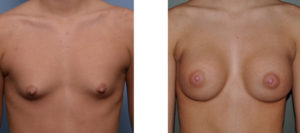
Pre-existing breast asymmetry is by far the common reason in my experience. Many women have some degree of differences between their breasts, some recognize it… others do not. Sometimes those differences are significant…often they may be quite subtle. I make it an important issue to look for it and point it out. It does not take much of a difference to become magnified when the breasts are enlarged by implants. In some cases, a small breast difference can be a much bigger one after surgery. In other cases, a small breast difference is actually improved by breast enlargement. How can you tell which one will happen for any particular patient?
The horizontal position of the nipples is the critical piece of anatomy to note. If differences in the two breast exist but the nipples are at the same horizontal level, it is likely that the breasts will not be significantly different after surgery. In some cases, they may be actually improved. If the breast differences are associated with nipples that are at different horizontal levels, however, there is a good chance the breasts differences will not be improved by implant enlargement. In fact, it is highly likely that the breast differences will look worse or become more apparent. The breast implants will make the mounds look larger and more symmetric but the position of the nipples on the breasts will become more horizontally different. This can create a ‘cockeyed’ or ‘walleyed’ look to the breasts as the nipple positions become more askew as the breasts have become larger.
There are methods to improve breast implant and nipple asymmetry after surgery but it is important for the higher risk patient to understand what their anatomy is to begin with. Patients understandably expect perfect breast symmetry after implant placement but this is not a realistic goal in the patient who wasn’t symmetric from the beginning.
Dr. Barry Eppley
Indianapolis, Indiana


